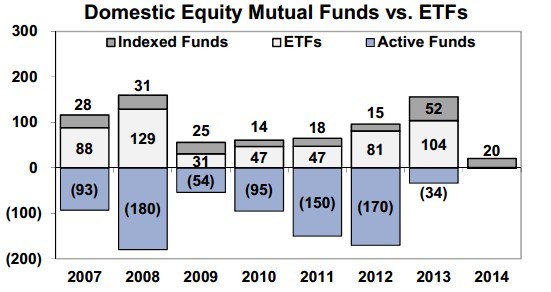Passive vs Active ETF Financial Web
Post on: 16 Март, 2015 No Comment

When you are considering a passive versus active ETF. you will need to think about the investment manager’s style rather than just the investments in the fund. A passive manager is one who allows the market to take turns without changing the assets in a portfolio immediately. An active manager is constantly manipulating the fund due to not only market turns but also anticipated market turns. Each fund is popular for unique reasons.
Advantages of a Passive Fund
There are two key advantages passive funds aim to achieve. The first is a reduction in costs related to transactions and maintenance. Each time an asset within a fund is exchanged, transaction fees incurred by the fund are passed on to its investors. When a manager attempts to lower the total number of transactions, the manager is lowering these fees. The second advantage passive funds seek is greater returns than overly active funds. There is some debate whether very active funds can actually out-perform the market. Particularly in a turbulent economy, evidence supports the fact passively managed funds perform just as well as actively managed funds.
Advantages of an Active Fund
Active ETFs seek to anticipate, respond to and even potentially manipulate the market through aggressive and frequent action. One of the key disadvantages will be transaction fees. However, proponents of ETFs argue these fees are more than compensated through higher returns. These individuals feel the right manager has the ability to make smart decisions to effectively change the performance of the ETFfor the better. Some active ETFs do perform very well on the whole, but the success of these funds depends more on the manager’s decisions than with a passive ETF. Investors in active ETFs typically have a higher appetite for risk and want to actively seek a fund manager.
Finding an Active Fund

You can take two routes to find an active ETF. The first is to actually watch the trading behaviors of a few high-performing ETFs. You can then assess which have activity that reflects your personal style. For example, some managers will almost immediately dump a stock for a corporation with a bad quarter. You may feel this is a bad move, or you agree with the decision. If you agree, the fund manager may match your style well. Watch a fund for at least 6 months before deciding. Alternatively, you can ask your investment adviser for recommendations for active ETFs.
Dealing with Style Drift
It is common for the style of certain fund managers to adapt over time. This is in response to the market as a whole, and it is not necessarily a bad thing. Some style drift is expected, particularly if you hold shares in the ETF for many years. However, you may be alarmed if there is a sudden and noticeable change in the style of management of your ETF without reasonable explanation. For an active fund, this may be a long period without activity. In this case, it is possible the fund manager or management style changed, and you may want to move on to another active ETF.
$7 Online Trading. Fast executions. Only at Scottrade














